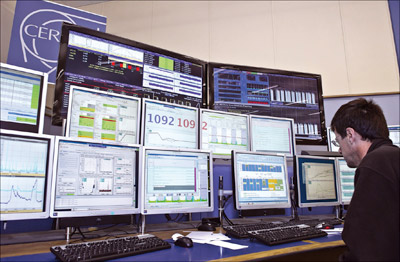
After some 180 days of running and 4 × 1014 proton–proton collisions, the LHC’s 2011 proton run came to an end at 5.15 p.m. on 30 October. For the second year running, the LHC team has largely surpassed its operational objectives, steadily increasing the rate at which the LHC has delivered data to the experiments.
At the beginning of the year’s run, the objective was to deliver an integrated luminosity of 1 fb–1 during the course of 2011. This came on 17 June, setting the experiments up well for the major physics conferences of the summer and requiring the 2011 data objective to be revised upwards to 5 fb–1. That milestone was passed by 18 October; when proton running ended, the LHC had delivered around 5.6 fb–1 to both the ATLAS and CMS experiments, 1.2 fb–1 to LHCb and 5 pb–1 to ALICE. Physics highlights for these four big experiments include closing down the space available for the long sought Higgs and supersymmetric particles to hide in, putting the Standard Model of particle physics through increasingly gruelling tests and advancing our understanding of the primordial universe.
“At the end of this year’s proton running, the LHC is reaching cruising speed,” comments CERN’s director for accelerators and technology, Steve Myers. “To put things in context, the present data-production rate is a factor of 4 million higher than in the first run in 2010 and a factor of 30 higher than at the beginning of 2011.”
Time has also been devoted to some special physics runs for the smaller TOTEM and ALFA experiments, which probe small-angle (forward) scattering, allowing them to measure the total proton–proton cross-section and the absolute luminosity calibration. In these runs, the beam is de-squeezed to a β* of 90 m in ATLAS and CMS. This is instead of the usual 1m β*, and gives a larger beam size at the interaction points – resulting in a reduced beam divergence there.
A number of factors have contributed to these impressive totals, including: the increase in the total number of bunches to 1380 during the first part of the year, the high bunch intensity and small beam sizes delivered by the LHC injectors, and the good aperture in the regions around ATLAS and CMS, which have allowed a squeeze to β* = 1 m. About 25% of the programmed physics time was spent with stable beams – which is not bad at this stage in the LHC’s career, given its complexity and the operation with high-intensity beams.
Following the end of proton running, a week of machine development began. An early high point was the cohabitation of protons and lead ions in the LHC – low-intensity beams of protons (clockwise) and lead ions (anti-clockwise) were successfully injected and ramped together. A first test of proton–lead collisions was scheduled to follow after commissioning for the lead-ion run and a 5-day technical stop. If successful, these tests will lead to a new strand of LHC operation, using protons to probe the internal structure of the much more massive lead ions.
As in 2010, the main goal before the end of year, however, is a four-week period of lead-ion running before the machine closes down for the winter technical stop.
• For regular updates and detailed information about the LHC, follow CERN’s Bulletin at http://cdsweb.cern.ch/journal/CERNBulletin/.








